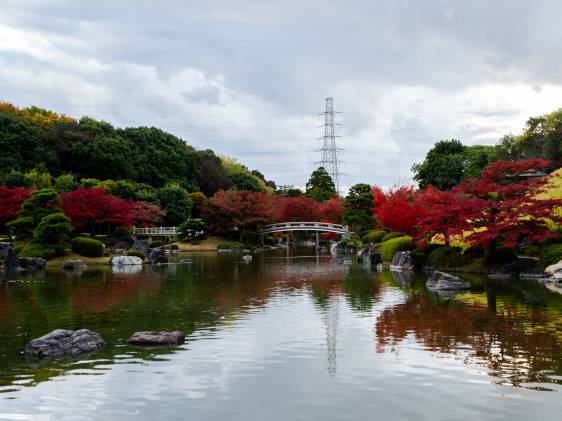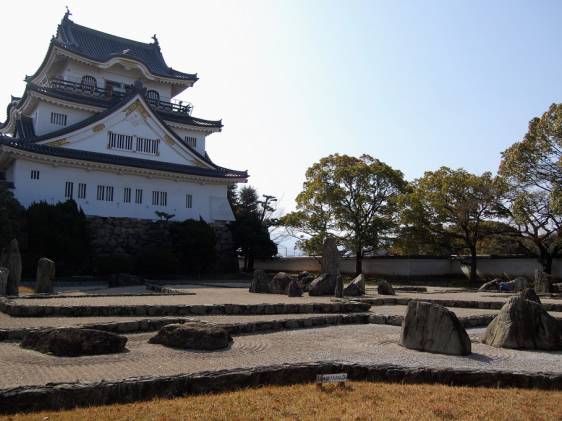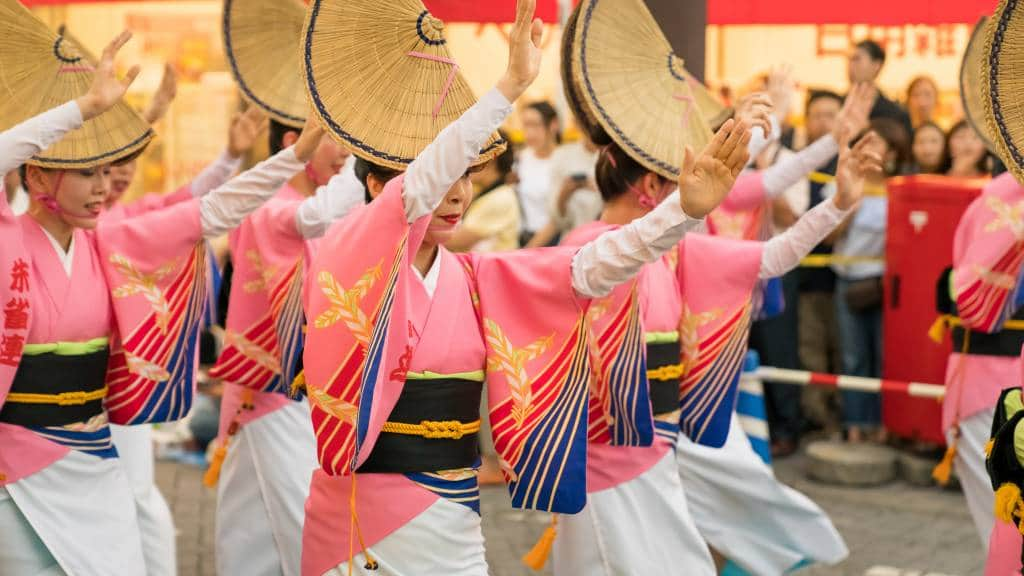As Japan’s kitchen, Osaka makes the perfect place for a hanami picnic. With spring in the air, here are the best spots to enjoy cherry blossoms in Osaka.
Osaka may not be as famously picturesque as its neighbor, Kyoto, when it comes to cherry blossom displays. However, don’t underestimate the power of pink petals to transform even the most urban of places. The gardens and parks of Osaka provide the most popular spots, and, as a livelier city, you’ll find more blue tarps than you ever thought possible (plus plenty of beer to go with them).
Pro tip: If you don’t have a lot of time to see cherry blossoms in Osaka, we recommend a sakura cruise, which takes you to Kyoto, too.
When is cherry blossom season in Osaka?
According to the 2025 cherry blossom forecast, the blossoms in Osaka are expected to appear around March 28 and to reach full bloom by April 4. As always, be sure to check the latest updates on the forecast, as it can change depending on the weather.
Pro tip: If you’re arriving later in April, be sure to visit the Japan Mint, which has free entry once a year and has late-blooming varieties of cherry blossom.
1. Osaka Castle
For classic hanami with a historic backdropFree
Central Osaka (10 minutes from Osaka Station)

Osaka Castle is the number one place to start both your sightseeing and hanami adventures. The castle grounds are filled with over 3,000 cherry trees, meaning there’s plenty of space to get the perfect shot.
In the west section, Nishinomaru Garden has super spots for a picnic. This is where lawns stretch beneath the trees (other areas have hard ground). Entry for the garden is ¥200, however; other areas are free.
The Osaka Castle Spring Festival runs from late February to mid April, allowing visitors to celebrate both the plum blossoms and cherry blossoms as they bloom.
2. Daisen Park
For a quiet escape with garden views¥200 for the Japanese Garden
Sakai (35 minutes from Osaka Station)
If you’re looking to escape the city for a day, we suggest you head out to Daisen Park, a spacious 35-hectare park with a large Japanese garden. It has 400 cherry trees and plenty of space to enjoy them. There are a few blossom varieties, including mountain cherry and Ōshima, but all the flowers together create an impressive scene, especially near Dada Pond.
The gardens have a tea house and other sights to explore, including the Sakai Museum, and a flower and water park. Note that the gardens are closed on Mondays.
3. Kema Sakuranomiya Park
For riverside cherry blossom strollsFree
Central Osaka (5 minutes from Osaka Station)

Located on the river terrace between Kema Araizeki and Temmabashi Bridge, Sakuranomiya Park is a beautiful stretch. Almost 5,000 cherry trees line the edges of the Ōkawa River — a sight that will take your breath away. During the blossoming, you’ll find food stalls and hanami picnics galore, creating a festival atmosphere.
Pro tip: This park is very close to the Japan Mint, so — depending on the timing — you can combine the two.
4. Japan Mint Bureau
For rare sakura, open just one weekFree (advance registration required)
Central Osaka (10 minutes from Osaka Station)

The Mint garden is usually closed to the public, but for one week during cherry blossom season, they open their gates, allowing visitors to admire some rare and unusual varieties of blossoms. Note that this event requires online registration in advance to enter the grounds.
Among the 350 trees are an impressive 134 different varieties, and the Mint is an especially good spot for late-blooming trees, like yaezakura. There is a tunnel effect, and it is one of the most picturesque spots in the city, with lanterns and evening illuminations.
Surprisingly, entry is completely free — although if you were planning on visiting the Mint Museum, it is closed for the duration of the garden opening. If you miss getting a reservation, don’t fret, the river just outside the Mint is also filled with Somei-yoshino cherry blossoms and food stalls.
5. Expo ’70 Commemorative Park
For spacious picnics and night illuminations¥260
Suita (northern Osaka; 25 minutes from Osaka Station)

Also known as Bampaku Kinen Kōen, this park was designed to host the 1970 Japan World Exposition. Famed for its seasonal flower displays and open spaces, Bampaku has over 5,000 cherry trees spread across 260,000 square meters, mostly along paths and in the southeast section. While it’s a popular spot, there is certainly enough space for it not to feel too crowded.
As part of the park’s annual cherry blossom festival, two teahouses in the Japanese Garden — normally off-limits to the public — are open on weekends. One of them sells matcha and sweet sets. There will also be evening illuminations.
Within the park, which is about 30 minutes from central Osaka, you’ll also find street performers, a Japanese landscape garden, artwork left over from the Expo, and two cultural museums to explore.
Middle School students: ¥80
Elementary School students: ¥80
6. Kishiwada Castle
For samurai vibes under the blossoms¥300
Kishiwada (southern Osaka; 40 minutes from Osaka Station)
Home to the famous Kishiwada Danjiri Matsuri, this castle was originally built in 1334 and has more than 130 blossoming trees surrounding it. The gardens include remains of the original castle (the current one was rebuilt in 1954 after many fires/disasters/battles) and a stone garden designed to represent the fortification.
Although the castle is around 25 minutes from Osaka central, it’s actually on the way to the airport, so you could make it your first or last stop in the city.
7. Hattori Ryokuchi Park
For sakura plus forests and farmhousesFree
Toyonaka (northern Osaka; 20 minutes from Osaka Station)
A large hilly park in northern Osaka, this park is well known for its open-air farmhouse museum and recreational pools, as well as its cherry blossoms. For a more spacious blossom experience with some additional entertainment on the side, this can make for a great afternoon out in Osaka.
The park has more than 10 ponds, a bamboo forest, an arboretum with over 700 species of camellia, and sports facilities, too. The museum is a great chance to see the gassho-zukuri houses of Shirakawagō if you haven’t been able to see them yet.
8. Tsurumi Ryokuchi Park
For dreamy pond reflections and flowersFree
Tsurumi (eastern Osaka; 20 minutes from Osaka Station)
Not to be confused with the park above (ryokuchi means “green space”), Tsurumi Ryokuchi Park was host to the International Garden and Greenery Exposition in 1990 and thus has a great selection of flower displays — including cherry blossoms.
You can picnic beneath the hundreds of cherry trees and also explore the grounds, which include a traditional Japanese garden, a rose garden with 2,600 plants, and a teahouse. The trees line the edges of a pond, creating beautiful reflections and dreamy sakura photo-ops as they begin to fall and float on the water’s surface.
The park is designed to have flowers in bloom during every season, so there are plenty of flowers to see aside from the cherry blossoms.
9. Sayama Pond
For peaceful walks around Osaka’s oldest pond.Free
Osaka-Sayama City (southern Osaka; 40 minutes from Osaka Station)
Looking for a peaceful spot to enjoy cherry blossoms without the Osaka crowds? Sayama Pond is the place. Just a quick 30-minute trip from the city center, this historic reservoir is a local favorite for hanami. Fun fact: it’s actually Japan’s oldest human-made pond, dating back to the 7th century. Having sustained farmers in the region for centuries, it’s now a go-to spot for seasonal strolls.
The 3 km loop around the pond puts on a proper show in spring, thanks to two types of sakura: Somei-yoshino (the classic, pale pink blooms) and koshinohigan (a lesser-known variety with a more vivid hue and an earlier bloom). If you time it right, you’ll catch the petals reflected in the still water, especially at the famous sakura tunnel.
10. Shukugawa Park
For a riverside tunnel of cherry treesFree
Nishinomiya, Hyōgo Prefecture (between Osaka and Kobe; 20 minutes from Osaka Station)

So, Shukugawa Park isn’t in Osaka proper, but it’s just a 20-minute ride away from Osaka City. The Japan Cherry Blossom Association named it among the top 100 spots for cherry blossoms, too, so you know it’s worth the journey.
This area has its own official sakura varieties: Nishinomiya-gongendairazakura, with its multi-layered, fluffy petals that deepen in color as they mature, and Shukugawa-maizakura, named as such because they appear to dance in the wind. Both bloom alongside 1,660 other cherry trees.
Frequently asked questions
When can you see cherry blossoms in Osaka?
In 2025, blossoms in Osaka are expected to appear around March 28 and reach full bloom by April 4.
Where is the best place to see cherry blossoms in Osaka?
The best place to see cherry blossoms in Osaka depends on what you’re after. Osaka Castle offers stunning views with 3,000 cherry trees. If you prefer a scenic riverside walk, Kema Sakuranomiya Park is the place. For something unique, the Japan Mint Bureau opens its garden for just one week, showcasing rare cherry blossom varieties.
While we do our best to ensure it’s correct, information is subject to change. This article was originally published in March 2018. Last updated in February 2025 by Aarohi Narain.






































